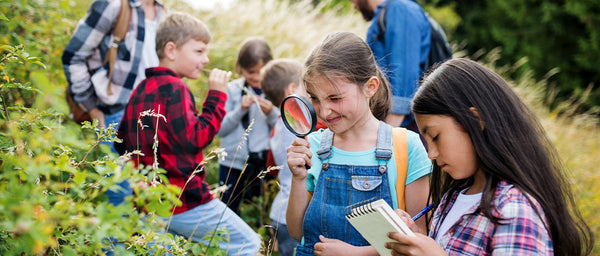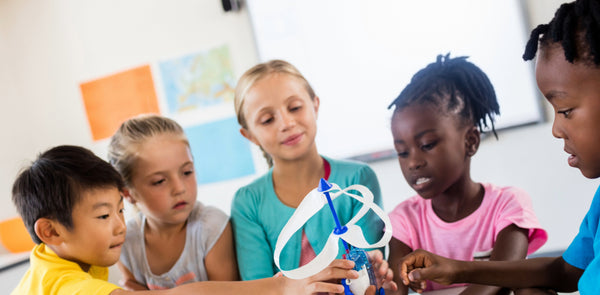
STEM Meets the Science of Reading
Teaching reading is a collaborative effort. While traditional English and elementary classroom educators do a tremendous job, out-of-school and STEM instructors also play a vital role in the process. Why? Because reading is a comprehensive blend of skills and ideas. STEM unites all educators who strive to provide well-rounded opportunities for their learners.
Before we explore why, let’s look at how we learn to read. The Simple View of Reading (Gough & Tunmer, 1986) boils it down to two parts
- Decode written words into sounds read aloud (word recognition)
- Understand the meaning behind those words (language comprehension)
Here, we’ll examine the latter. Even if every word in a sentence is perfectly decoded, learners must actively engage with the text and the surrounding world to grasp its meaning. In other words, familiarity with terms and experiences that bring them to life can impact understanding. That’s where STEM becomes the ultimate literacy tool.
STEM puts language comprehension into practice, consistently providing meaningful experiences that learners can use to improve their reading comprehension.
Scarborough’s Reading Rope shows how reading comprehension breaks down into five parts: background knowledge, vocabulary, language structure, verbal reasoning and literacy knowledge (Scarborough, 2001). Each plays a pivotal role in developing strong comprehension skills and is supported by STEM instruction that engages learners through multiple modes and senses.

Read on to discover how Plants and Seeds (Grades 1-3) and Ready, Set, Drone! (Grades 4-8), two of our many exciting STEM programs, support the Science of Reading, helping educators seamlessly implement this powerful teaching tool.
Background Knowledge and Vocabulary
Background knowledge and vocabulary are two known predictors of successful reading comprehension. We don’t sit down to memorize the dictionary. Instead, we learn words when we hear how they are used in context. Experiences like visiting a zoo or caring for a garden, for example, can give us insights and terminology that we can apply to our reading. This may not be possible for all learners, however. Both learner population and resource availability can be limiting factors for young readers.
STEM programs immerse learners in content over an extended period, allowing them to explore topics they may not otherwise have been exposed to.
(For more on creating an equitable learning environment for learners, check out 4 Ways STEM Meets Your Equity Goals)
Plants and Seeds:
A shared read-aloud is a great way to build vocabulary and background knowledge. Sharing favorite stories, modeling fluent reading, introducing specific vocabulary, and addressing specific learning objectives are some of the many benefits of storytime. From its very first lesson, Plants and Seeds uses books to do just that!

Before planting, learners familiarize themselves with terms and concepts related to plants and seeds. In Anne Rockwell's One Bean, they discover vocabulary such as potting soil and sprouted, enabling them to recognize and use these terms themselves. Revisiting the text during hands-on planting activities also promotes the retention of terms. All in all, learners gain a foundation to draw from when they encounter these words again.
Did you know you can turn any story into an exciting STEM challenge? You can Bring Stories to Life with STEAM using our simple tips and tricks.
Ready, Set, Drone!
The flexibility of Ready, Set, Drone! allows learners to explore, further building their background knowledge and vocabulary. In lesson 6, learners investigate scientific questions about how drones fly. As suggested in the Instructors’ Guide, the next step may be to conduct background research in the library, talk to others about the topic, collect qualitative observations, or organize a controlled experiment. As a result, they are empowered to examine the unpredictable and intriguing questions that complete their understanding.
As a bonus, this program gives learners access to technology outside the scope of a traditional classroom, enabling them to interact with the content directly. Its 12 hands-on lessons engage learners as they manage and pilot drones firsthand, which is extremely valuable for developing background knowledge. It's an exciting, unique experience that learners can draw from again and again.
Language Structure:
The English language is rich with syntax rules. Good readers continuously explore how words and phrases come together to create meaning. It’s a complex endeavor, but what better way to practice the art of language than through conversation!
Discussion is at the heart of every STEM lesson. Certainly, conversations naturally happen as learners work together, but group discussion prompts found throughout Plants and Seeds provide targeted learning opportunities. For example, after watching an exploding seed pod video to demonstrate seed dispersal, educators can choose from a list of possible discussion questions:
- What did we just see?
- What causes the explosion?
- Why would it be important for a seed pod to explode?
While engaged in conversation, learners listen and can internalize how their peers and teachers use scientific terms to explain ideas. Combined with the background knowledge and vocabulary they have gained, this translates to reading comprehension, helping them create meaning in sentences that use similar words and phrases.
Want to take things a step further? Look for opportunities to teach morphology and study how roots, prefixes, suffixes, etc. come together to create meaning. Often derived from Greek or Latin roots, scientific terms found in any STEM text are likely ripe with terms that showcase similar morphemes. Hunt for them with learners during your next Guided Reading lesson.
Incidentally, you may notice the word "Droneology" mentioned throughout Ready, Set, Drone! While you’re surely excited by the morphology found in this new word (root word: drone suffix: ology [a subject of study]), you’re curious about what it has to offer. Droneology is an exciting way for beginner and advanced users to learn about drone safety, laws and regulations, flight basics and the many uses of drones. Your learners will be Droneologists in no time with these fun e-courses!
Verbal Reasoning:
Great STEM innovators and readers use inferences to draw conclusions. It’s a necessary skill for making sense of an environment, whether in the real world or within the context of a story. Inferring is essential to solving problems and evaluating situations.
Inferences are drawn by connecting what we observe to prior knowledge and new information perceived through our senses. All PCS Edventures programs include manipulative-based activities that encourage learners to assess multiple observations in order to draw valuable inferences. Here’s a sneak peek at some awesome hands-on lessons from our two featured programs:
Plants and Seeds:
Practice making inferences with an engaging “Who Done It?” activity! Using the information provided, learners work together to determine how seeds travel across environments. Give it a try! What mode of seed dispersal is described below?
- Humans, plants and animals need me to survive.
- I carry seeds long distances, and some seeds are even designed to float on me.
- About 71% of the Earth’s surface is covered with me.
If you said water, you’re right! Discover more Who Done It? clues in Plants and Seeds or challenge your learners to create their own. It’s a great exercise for developing reasoning and evidence-based conclusions.
Ready, Set, Drone!
On Day 3 of their flight journey through Ready, Set, Drone!, learners experiment with piloting drones. They begin by studying the four main radio controls: throttle, pitch, yaw and roll. As previously discussed, understanding specific vocabulary is necessary for comprehension. In this case, educators ensure a common language among novice and advanced drone users, giving all the ability to coach each other and immediately respond to commands.
As group members take turns behind the controls, they make observations that lead to inferences:
- Prior Knowledge: What have I learned in previous lessons about lifting off from the launch pad that I can apply to today’s flight?
- New Information: How do each of the four radio controls affect flight patterns? What will happen if I use controls in combination with one another?


Through continued practice, learners anticipate how their drones respond to control input and fly them with confidence.
Literacy Knowledge:
Reading exposes learners to more types of literacy. The more genres they encounter, the more advanced their literacy knowledge becomes. STEM instruction includes much more than nonfiction reading. Fiction, nonfiction, poetry, and media literacy in all their forms work together to provide learners with a comprehensive learning experience.
Plants and Seeds:
We’ve already explored some of the many fiction read-alouds, videos and activities found throughout Plants and Seeds. Each does its part in exposing learners to a variety of literacy genres. Check out this mini book learners get to create. It's a memorable way to familiarize themselves with the components of informational texts.

Ready, Set, Drone!
Even journaling is a form of literacy. As a lesson extension that helps learners further explore a variety of genres, Ready, Set, Drone! suggests exploring Galileo and da Vinci’s scientific journals about flying machines. Several other books for each grade level are recommended as well, showcasing journaling as a practice that extends across all disciplines of science.
Reading Instruction Comes from Everywhere:
Out-of-school educators, what you do in your learning environment can directly impact learners' reading comprehension. STEM experiences provide learners with opportunities to gain the background knowledge necessary to find meaning in what they read. It encourages active listening and practicing the art of language while immersing them in a variety of texts they’ll benefit from throughout their adult lives.
Reading is a taught skill. It takes years of hard work, patience and complex thought. STEM adds excitement to the journey, giving young readers the chance to engage with content and reading material in a whole new way.
Educators, asSTEMble!
Excited to use STEM to help learners become super readers? Share this post on social media to help other educators answer the call!

Author: Jessica Ventre
An experienced elementary educator and science instructional coach, Jessica’s passion for STEM instruction and student-led learning is always at the forefront of her lessons and professional development workshops.
References:
Amplify Education, Inc. (2022, December 21). Amplify Science of Reading. Retrieved December 31, 2022, from https://scienceofreading.amplify.com/
Gough, P. B., & Tunmer, W. E. (1986). Decoding, Reading, and Reading Disability. Remedial and Special Education, 7(1), 6–10. https://doi.org/10.1177/074193258600700104
Rockwell A. F. & Halsey M. (1998). One Bean. Walker.
Scarborough, H. S. (2001). Connecting early language and literacy to later reading (dis)abilities: Evidence, theory, and practice. In S. Neuman & D. Dickinson (Eds.), Handbook for research in early literacy. New York: Guilford Press.










1 comment
Thank you for puting itin writing! This is how I have always thought about it and suggested at our school that we rename the experience STREAM. In fact, our Teachers of English are a strong part of the process from beginning to end.